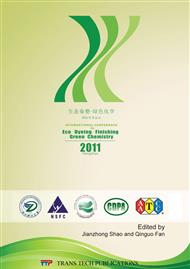p.578
p.584
p.589
p.593
p.598
p.603
p.608
p.613
p.619
Photocatalytic Degradation Kinetics of Reactive Red 3BS Using Ag Doped TiO2
Abstract:
The photocatalyst of Ag doped TiO2 in liquid state was applied to decolorize the Reactive Red 3BS under UV irradiation. The rate of photocatalytic degradation of the dye was improved with increasing the concentration of catalyst from 1 g/L to 8 g/L. But as a result of light attenuation for the rising catalyst concentration, the rate of reaction was constant at 8-12 g/L of the catalyst concentration. The rate of dye photocatalytic degradation decreased with increasing initial concentration of dye. The kinetics of photocatalytic reaction was also studied. The results showed that degradation reaction is congruent with an apparent first-order kinetic equation, and the relationship between apparent reaction rate and initial dye concentration fits approximately a negative second-order kinetic relationship.
Info:
Periodical:
Pages:
598-602
Citation:
Online since:
January 2012
Authors:
Keywords:
Price:
Сopyright:
© 2012 Trans Tech Publications Ltd. All Rights Reserved
Share:
Citation:


